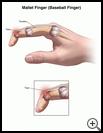
Mallet Finger (Baseball Finger): Teen Version
________________________________________________________________________
KEY POINTS
- Mallet finger, also known as baseball finger, is a tear in one of the tendons in your hand. Tendons are strong bands of tissue that connect muscle to bones.
- Your healthcare provider will straighten your finger and put it in a splint for 6 to 12 weeks. Your provider may recommend stretching and strengthening exercises to help you heal after the splint is no longer needed. If the injury is severe, you may need surgery.
________________________________________________________________________
What is mallet finger?
Mallet finger, also known as baseball finger, is a tear in one of the tendons in your hand. Tendons are strong bands of tissue that connect muscle to bones. The muscles that move the fingers are in the forearm. Long tendons go from these muscles, through the wrist, to the small bones near the tip of the fingers. These tendons are used to extend or straighten your fingers.
What is the cause?
Mallet finger is usually caused by a jamming injury to the tip of the finger. This can happen with any activity where there is a blow to the tips of your outstretched fingers, such as catching a ball in baseball, basketball, or volleyball. The stress of the injury can pull the tendon off the bone, tear a small piece of bone off the finger, or tear the tendon itself.
What are the symptoms?
You may have pain and swelling at the tip of the finger, and not be able to straighten the tip of your finger. If you don’t get medical care within a week or two after the injury, you may permanently lose the ability to straighten your finger.
How is it diagnosed?
Your healthcare provider will examine you and ask about your symptoms, activities, and medical history. You may have X-rays or other scans.
How is it treated?
Your healthcare provider will straighten your finger and put it in a splint for 6 to 12 weeks. This will allow the tendon to reattach to your finger bone or, if a piece of bone has been pulled off, to allow the bone to heal.
Your provider may recommend stretching and strengthening exercises to help you heal after the splint is no longer needed.
If the injury is severe, you may need surgery to repair the tendon or reset the bone.
How can I take care of myself?
To reduce swelling and pain for the first few days after the injury:
- Put an ice pack, gel pack, or package of frozen vegetables wrapped in a cloth, on the area every 3 to 4 hours for up to 20 minutes at a time.
- Keep your hand up on a pillow when you sit or lie down.
- Take nonprescription pain medicine, such as acetaminophen, ibuprofen, or naproxen. Read the label and take as directed. Unless recommended by your healthcare provider, you should not take these medicines for more than 10 days.
- Nonsteroidal anti-inflammatory medicines (NSAIDs), such as ibuprofen, naproxen, and aspirin, may cause stomach bleeding and other problems. These risks increase with age.
- Acetaminophen may cause liver damage or other problems. Unless recommended by your provider, don't take more than 3000 milligrams (mg) in 24 hours. To make sure you don’t take too much, check other medicines you take to see if they also contain acetaminophen. Ask your provider if you need to avoid drinking alcohol while taking this medicine.
Follow your healthcare provider's instructions, including any exercises recommended by your provider. Ask your provider:
- How long it will take to recover
- If there are activities you should avoid, including how much you can lift, and when you can return to normal activities
- How to take care of yourself at home
- What symptoms or problems you should watch for and what to do if you have them
Make sure you know when you should come back for a checkup. Keep all appointments for provider visits or tests.
How can I help prevent mallet finger?
Mallet finger is caused by a direct blow to the end of the finger during an accident that may be hard to prevent. Follow the safety rules for your work or sport and use protective equipment, such as gloves, taping, splinting, or protective strapping before a game.
Last modified: 2019-08-07
Last reviewed: 2019-08-07

